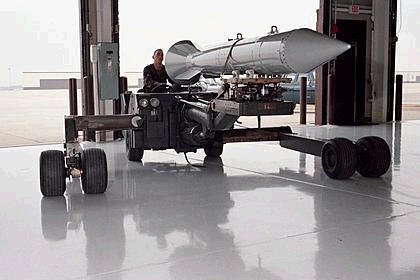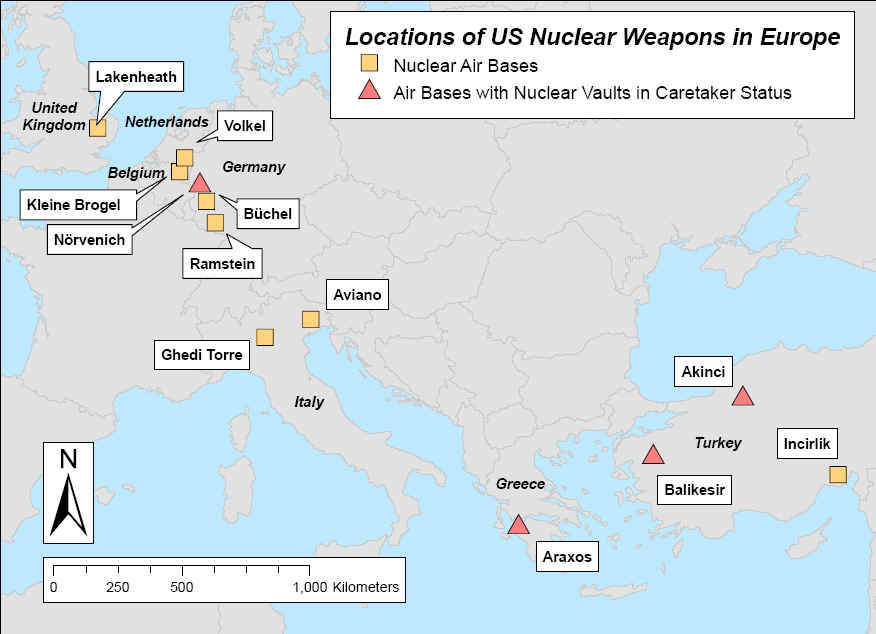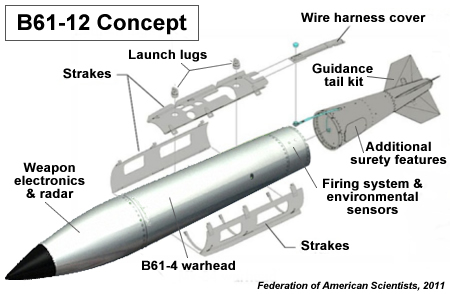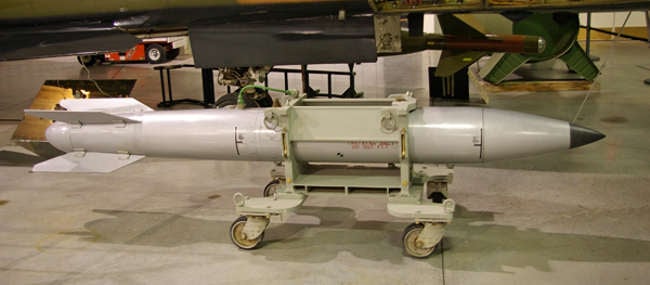“First Strike” Pre-emptive Nuclear War directed against Iran. The Alliance’s Nine Nuclear Weapons’ States

In defining who are the main actors in the Iran pre-emptive nuclear warfare equation, the definition of “nuclear weapons states” (NWS) must be addressed. Thermo-nuclear weapons are deployed by the three “official” Nuclear Weapons States (NWS) of the Atlantic Alliance, namely the US, the UK and France. The official NWS status is established under the terms of the Nuclear Non-Proliferation Treaty (NPT).
Five other NATO member countries (categorized under the NPT as “non-nuclear states”), namely Belgium, Germany, the Netherlands, Italy and Turkey, possess an arsenal of B61 tactical nuclear warheads or “mini-nukes” (Made in America) which are deployed under national military command and are targeted at Iran. The B61 can be delivered by a variety of different aircraft.
Are these five countries in violation of the Nuclear Proliferation Treaty of which they are signatories?
Nine Nuclear Weapons Countries
In relation to ongoing war plans, the US-NATO-Israel military alliance includes a total of nine countries which possess a nuclear weapons arsenal:
- The three official NWS: United States, United Kingdom, France
- The five “Undeclared Nuclear States”: Belgium, Germany, Netherlands, Italy and Turkey, categorized as “Non-Nuclear States”.
- Israel: “Undeclared Nuclear State”.
With the exception of Israel, these countries are signatories of the NPT.
Pre-emptive Nuclear Warfare
While reports tend to depict the tactical B61 bombs as a relic of the Cold war era, the mini nukes are the preferred weapons system of pre-emptive nuclear war. Were an attack directed against Iran to be launched involving the deployment of B61 bunker buster nuclear bombs, these five countries, with Turkey and Italy in the forefront, would be playing a major strategic role.

A B-2A bomber releases a test version of the new B61-11 gravity bomb over the Tonopah Test Range in Nevada, November 20, 1996 (left)
The involvement of these five “non nuclear states” as major actors in a US sponsored pre-emptive nuclear war raises the issue of definition and categorization of nuclear weapons states. In the words of Time Magazine:
“Is Italy capable of delivering a thermonuclear strike?…
Could the Belgians and the Dutch drop hydrogen bombs on enemy targets?…
Germany’s air force couldn’t possibly be training to deliver bombs 13 times more powerful than the one that destroyed Hiroshima, could it?…
Nuclear bombs are stored on air-force bases in Italy, Belgium, Germany and the Netherlands — and planes from each of those countries are capable of delivering them.” (“What to Do About Europe’s Secret Nukes.”Time Magazine, December 2, 2009)
The Time report is careful not to address the fundamental question. Are Turkey and Italy nuclear weapons states? The B61s are described as a leftover from the Cold War. The issue of post 9/11 pre-emptive warfare is not mentioned:
“These weapons are more than a historical oddity, says Time. They are a violation of the spirit of the Nuclear Non-Proliferation Treaty (NPT) … that provides a legal restraint to the nuclear ambitions of rogue states.” (Ibid).
While Iran does not possess nuclear weapons capabilities as confirmed by the latest US National Intelligence Estimate (NIE), the nuclear weapons potential of these five countries –including delivery procedures– are formally acknowledged.
These five countries possess WMDs, yet they do not constitute –in the eyes of public opinion– a threat to global security. Moreover, at no time have these five countries been designated as “rogue states” or “undeclared nuclear weapons states”.
US and NATO military documents attest to the fact that the B61 is the weapon of choice of pre-emptive nuclear war as opposed to the larger thermo-nuclear bombs of the Cold War era.
Moreover, were military action to be launched against Iran, these five countries would play a key role in the delivery of B61 bunker buster bombs with nuclear warheads.
The US had originally supplied some 480 B61 thermonuclear bombs to these five “non-nuclear states”, as well as to the United Kingdom, which is categorized as a Nuclear Weapons State (NWS). (See map below)

RNEP: The Follow-On To B61-11 (right), Nuclear Information Project, The B61-11 The Birth of A Nuclear Bomb (image: right)
Casually disregarded by the Vienna based UN Nuclear Watchdog (IAEA), the US has actively contributed to the proliferation of nuclear weapons in Western Europe and Turkey. While, some of these bombs were decommissioned as a result of political pressures, particularly in Belgium and Germany, the US –in liaison with NATO– has launched a multibillion dollar modernisation program of its tactical nuclear weapons arsenal.
According to the National Resources Defense Council (August 2007), the number of B61 nuclear bombs in Europe has been reduced from 480 to 350, following the removal of 130 bombs from the Ramstein airbase in Germany.
As part of this European stockpiling and deployment, Turkey, which is a partner of the US-led coalition against Iran along with Israel, possesses some 90 thermonuclear B61 bunker buster bombs at the Incirlik nuclear air base. (National Resources Defense Council, Nuclear Weapons in Europe, February 2005). This is all the more significant in view of the “reconciliation” and renewed bilateral military cooperation between Ankara and Tel Aviv in the wake of President Obama’s March visit to Israel.
The stockpiling and deployment of tactical B61 (including the B61-11 earth penetrating warhead) in these five “non-nuclear states” are intended for targets in the Middle East. In accordance with “NATO strike plans”, these thermonuclear B61 bunker buster bombs (stockpiled by the “non-nuclear states”) could be launched against Iran, Syria and Russia:
The approximately 480 nuclear bombs in Europe [350 according to 2007 estimate] are intended for use in accordance with NATO nuclear strike plans, the report asserts, against targets in Russia or countries in the Middle East such as Iran and Syria.
The report shows for the first time how many U.S. nuclear bombs are earmarked for delivery by non-nuclear NATO countries. In times of war, under certain circumstances, up to 180 of the 480 nuclear bombs would be handed over to Belgium, Germany, Italy, the Netherlands and Turkey for delivery by their national air forces. No other nuclear power or military alliance has nuclear weapons earmarked for delivery by non-nuclear countries.”
(quoted in Nuclear Information Project, Nuclear Weapons in Europe. 2005. See full report at National Resources Defense Council, Nuclear Weapons in Europe, New York, February 2005)

Nuclear Information Project, The B61-11 The Birth of A Nuclear Bomb
Does this mean that Iran or Russia, which are potential targets of a nuclear attack originating from one or other of these five so-called non-nuclear states should contemplate defensive pre-emptive nuclear attacks against Germany, Italy, Belgium, the Netherlands and Turkey? The answer is no, by any stretch of the imagination.
While these “undeclared nuclear states” casually accuse Tehran of developing nuclear weapons, without documentary evidence, they themselves have capabilities of delivering nuclear warheads, which are targeted at Iran. To say that this is a clear case of “double standards” by the IAEA and the “international community” is a understatement.

(Source: National Resources Defense Council, Nuclear Weapons in Europe , February 2005)
While political pressures have been exerted in recent years towards decommissioning the stockpile of tactical nuclear weapons, the arsenal of B61 bunker buster bombs with nuclear warheads remains fully operational. In the case of a conflict with Iran, mini nukes in the five non nuclear states would be actively deployed in liaison with NATO, which as fully endorsed the doctrine of nuclear pre-emption. According to the Pentagon:
… keeping these weapons in Europe is that they allow NATO members to participate in shaping alliance nuclear policy [i.e. pre-emptive nuclear doctrine]. In this view, transatlantic ties are strengthened when the risks and costs of deploying and securing nuclear weapons are shared between the US and the respective host nations. (Quoted in “Parting words: Gates and tactical nuclear weapons in Europe”. Bulletin of Atomic Scientists, 14 July 2011)
Modernising the Mini-Nukes Arsenal
The decommissioning of the B61 nukes stockpiled in Western Europe and Turkey is a smokescreen. The European tactical nuclear weapons project is not being phased out as some reports have suggested. Quite the opposite. In 2010, the US National Nuclear Security Administration initiated a program “to refurbish and extend the life of the B61 bomb” at an initial estimated cost of 4 billion dollars (Ibid). By 2012, the mini nukes refurbishing program had skyrocketed to $10 billion. (US Department of Defence, Case Independent Cost Assessment for B61 LEP, Washington, July 13, 2012)
Described by the Federation of American Scientists, as “a gold plated nuclear bomb project”, this initiative consists in modernizing the existing pre-emptive nuclear arsenal of B61 tactical nuclear weapons deployed in the five undeclared nuclear states. Moreover, a new version of the B61 bunker buster bomb is envisaged: the B61-12. The latter is to be developed for deployment in Western Europe and Turkey with the backing of NATO and the German government, (Federation of American Scientists, November 2012).
The Obama administration and Congress have pushed the program forward despite the enormous cost … of refurbishing such complex weapons … Advocates, including the Obama administration, argue that the bomb is still essential to U.S. national security. In their view, the B61s deployed in Europe are the most concrete example of shared responsibility among the NATO countries,providing the indispensable psychological glue that binds the often-fractious alliance…. The B61 provides a case study in the expense and innovations driving the ambitious effort to maintain the nation’s nuclear defenses at a time of fiscal constraints and a shift away from reliance on nuclear deterrence. (Washington Post, September 16, 2012 emphasis added)
Reports from Turkey confirm that the B61-12 is slated for delivery in 2019.

Germany: Nuclear Weapons Producer
Among the five “undeclared nuclear states”, “Germany remains the most heavily nuclearized country with three nuclear bases (two of which are fully operational) and may store as many as 150 [B61 bunker buster ] bombs” (National Resources Defense Council, Nuclear Weapons in Europe. In accordance with “NATO strike plans”, these tactical nuclear weapons are also targeted at the Middle East.
While Germany is not categorized officially as a nuclear weapons state, it produces nuclear warheads for the French Navy. It stockpiles tactical nuclear weapons (Made in America) and it has the capabilities of delivering nuclear weapons. Moreover, The European Aeronautic Defense and Space Company – EADS , a Franco-German-Spanish joint venture, controlled by the powerful Daimler Group is Europe’s second largest military producer, supplying .France’s M51 nuclear missile.
Germany imports and deploys tactical nuclear weapons from the US. EADS produces nuclear warheads which are exported to France. Yet Germany is classified as a non-nuclear state.
Dangerous Cross Roads
The tactical nuclear weapons deployed by the five non declared nuclear states are under national command and could be used in a pre-emptive US-NATO sponsored nuclear attack against Iran.
Tactical nuclear weapons are also deployed by Israel.
While it is unlikely that nuclear weapons would be used at the outset of an attack, they could be envisaged as part of a scenario of military escalation.
It is, therefore, important that public opinion in Western Europe, Turkey and Israel be made aware of the consequences of pre-emptive warfare and that political pressures be exerted on the governments of these 5 countries, with a view to blocking the deployment of the B61 nuclear warheads in their respective military bases as well withdrawing outright from ongoing US-NATO pre-emptive war plans directed against Iran.
Tactical nuclear weapons are in essence slated to be used against non-nuclear states in the middle East. Their use was contemplated in both the Iraq war in 2003 as well against Libya in 2011.
The focus on tactical nuclear weapons (mini-nukes) as part of the conventional war arsenal, does not mean that the the US and its allies have scrapped the idea of using their arsenal of larger strategic thermonuclear weapons. While the latter would not be used against a non-nuclear state in the Middle East, they are deployed and targeted against Russia, China and North Korea.

For those who believe that the use of thermonuclear nuclear weapons belongs to a bygone era, think twice.
Nuclear Weapons and the Economic Crisis
While the Pentagon’s modernization budget for the pre-emptive nuclear option is a modest ten billion dollars (excluding the outlays by NATO countries). the budget for upgrading the US arsenal of “strategic nuclear offensive forces” is a staggering $352 billion over a ten year. (See Russell Rumbaugh and Nathan Cohn, “Resolving Ambiguity: Costing Nuclear Weapons,” Stimson Center Report, June 2012)
These multibillion military outlays allocated to develop “bigger and better nuclear bombs” are financed by the massive economic austerity measures currently applied in the US and in NATO countries.
The war economy is largely funded by compressing all categories of civilian government expenditure. In the US, these refurbished state of the art nuclear bombs are largely funded by the dramatic cuts in Medicare, Medicaid and Social Security.
Humanity is at a dangerous crossroads. America is a “Killer State”. The gamut of economic austerity measures impoverish the American people while generously funding the “Killer State” through multibillion contracts to Lockheed Martin, Northrop Grumman, Raytheon et al
War preparations to attack Iran are in “an advanced state of readiness”. Hi tech weapons systems including nuclear warheads are fully deployed.
At the height of an Economic Depression, “War is Good for Business”.
Escalation is part of the military agenda. While Iran, is the next target together with Syria and Lebanon, the US-NATO military agenda also threatens Russia, China and North Korea.
We call upon people across the land, in America, Western Europe, Israel, Turkey and around the world to rise up against this diabolical military project, against their governments which are supportive of military action against Iran, against the media which serves to camouflage the devastating implications of a war against Iran.
The Western media, the Washington Think Tanks, the scientists and politicians, in chorus, obfuscate the untold truth, namely that war using nuclear warheads threatens the future of humanity.
The real threat to global security emanates from the US-NATO-Israel alliance.
For further details on the dangers of Nuclear War, see the author’s most recent book: Towards a World War III Scenario: The Dangers of Nuclear War, Global Research, Montreal, 2011
An earlier version of this article was published by RT Op-Edge



